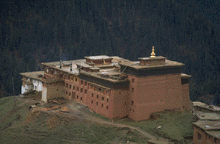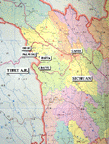Conservation Training Sites: Palpung and Baiya Monasteries
 |
| Mural painting in informal style. |
With support from the Getty Grant Program, in 1991 the China Exploration
and Research Society conducted a survey of 18 monasteries in western Sichuan province,
documenting their history, architectural design, and current condition. The expedition
focused on western Sichuan Province, Ganzi Prefecture, which has many architecturally
significant monasteries. As a result, two outstanding candidates were selected for
restoration.
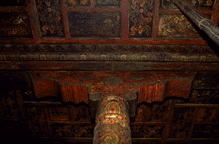 |
| Ornate ceiling of Situ Rinpoche's quarters in
Palpung. |
The first monastery selected is Palpung Gonpa. Palpung's main building
is remarkable for its huge size, complex design, and magnificent craftsmanship--so
splendid that it has been called the "Little Potala Palace" after the Dalai
Lama's famous (former) home in the Tibetan capital. Palpung ("Babang" in
Chinese) is traditionally a major teaching center for the Karma Kagyu sect, each year
receiving many young scholars. Located in a forested valley six horseback-hours from the
nearest motorable road, Palpung has suffered both from neglect during the Cultural
Revolution and an earthquake that struck in 1993, bringing portions of the building to the
verge of collapse. Repair of Palpung Monastery is a complex and expensive engineering
project that is well beyond the capacity of local resources, yet if the work is not done
soon the building will have to be abandoned--this would mean the loss of an architectural
masterpiece.
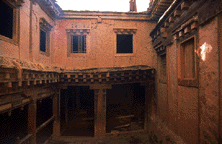 |
| Northeast courtyard of Palpung shows movement of major
structures. |
Four hours' travel from Palpung lies our second target: tiny Baiya
Gonpa. This Sakya sect monastery is famous for its numerous finely-done and historically
significant murals, which are in serious danger as the building threatens to collapse
around them. Baiya's murals are one of the few remaining examples of a style developed in
the Dege Kingdom (now county) over the last few centuries. Besides showing images of
Buddhist deities, they also depict the court of King Dengba Tsering, who once ruled
twenty-five tribes on the eastern plateau. The masterful technique displayed in these
murals is far superior to modern works; conservation of Baiya's murals and building will
allow them to be studied and enjoyed by future generations.
Program Impact Beyond the Initial Sites
The impact of our conservation work will spread far beyond Palpung
and Baiya, for well-trained engineers and conservators will find their skills in demand
all over the Tibetan plateau. Moreover, some of their skills will be applicable to
ordinary Tibetan homes. Tibetan architecture in general has several design deficiencies
that we plan to address, most notably resistance against earthquakes. Also, leaking roofs
and poor interior ventilation are health hazards that can be remedied using inexpensive
materials and only minor changes of design. Thus, not only will this project help preserve
Tibetan culture, it will improve the health and quality of life for ordinary Tibetans.
Another effect of the program will be to instill in Tibetans an
appreciation for their past. Already more educated Tibetans realize the value of
preservation, but rural people (whose sons represent the majority of the monk population)
tend to consider mural paintings as offerings, not as treasures to be cherished and
preserved. A large scale--and expensive--conservation project will spread the word to
ordinary farmers and herdsmen that their cultural legacy is indeed valuable--not only to
them, but to the world at large.
Work Completed So Far
In 1991, with funding from the Getty Grant Program, the China
Exploration and Research Society surveyed eighteen monasteries, producing a report that
contained never-before-documented building plans, histories, economic data. As a result,
Palpung and Baiya were identified as outstanding candidates for conservation. Based on
this work the project was selected by Rolex for an Honorary Award for Enterprise.
In 1994 two expeditions were fielded to further document the condition
of the most important targets. Conservation architect John Sanday established a
preliminary plan of action for Palpung and Baiya, and decided what other conservation
expertise is needed. Funds were provided to both monasteries for timber acquisition in
preparation for future work.
In 1996 extensive restoration work is slated to begin at both Baiya and
Palpung Monasteries. Although the groundwork has been laid for participation of
conservation expert John Sanday to lead the construction effort, as yet not enough funds
have been raised to pay for his return journey to Dege County. The leaders of both
monasteries have decided that they cannot wait any longer; therefore traditional methods
of repair will be used for the initial work.
A field team visiting Palpung in May, 1996 found that rotten timbers
were being torn out and a part of the roof replaced, but no innovative technologies had
been incorporated due to lack of expert guidance. At Baiya, work is scheduled to begin in
autumn. It is hoped that Sanday can return to Palpung and Baiya to oversee the repairs
before the work reaches an advanced stage.
For further updates, check the updates section at the top
of this page. (Click here.)
Future Plans
Depending on funds availability, earthquake safety measures will
be implemented at Palpung and Baiya, and new water proofing materials will be incorporated
in the roofs of the two monasteries. Tibetan workers will participate in this work so that
they can learn the techniques of conservation.
|
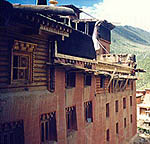 6/13/99
A new
6/13/99
A new 